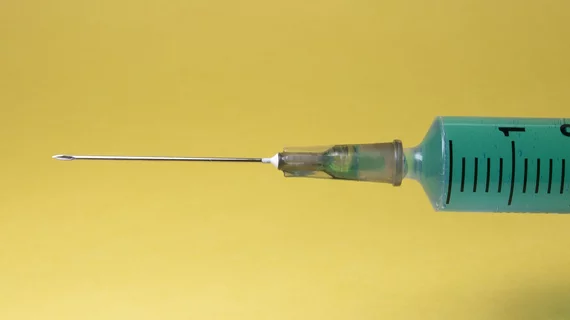Absenteeism leaps in radiology amid COVID-19 vaccine rollout, highlighting need for future planning
Radiology departments are seeing absenteeism rates climb as staffers grapple with side effects after receiving the COVID-19 vaccination, according to a new analysis published June 12 in JACR.
At the large-scale University Hospital Cleveland Medical Center, a total of 96 imaging employees called in sick after receiving their shot, with the vast majority following the second dose. The health system lost more than 344 hours of employee time due to this interruption, mostly split between technologists and nurses.
Lead author Kaushik Chagarlamudi, MD, and colleagues believe their data underline the importance of planning for future vaccination rollouts as the pandemic continues to unfold.
“Our findings highlight the need for institutions to prevent disruptions in workflow and avoid delays in patient care for a preventable problem,” Chagarlamudi, a University Hospitals diagnostic radiology resident, and colleagues concluded. “As the coronavirus naturally mutates, new variant strains will likely continue to create public health issues and possibly elicit the necessity of booster shots or seasonal shots. Armed with this information, large scale employers can be better prepared as millions of Americans will receive their vaccines in the coming weeks and months.”
For the study, University Hospital researchers gathered employee data covering 14 hospitals and 57 imaging centers in a single organization. That included the main 1,032-bed flagship academic medical center, which offers comprehensive imaging services. All told, 316 radiology employees met the criteria for the retrospective study, which spanned Dec. 23 through Feb. 28.
Eight employees did not report to work the day after their first vaccine dose, the authors found, while 88 did the same after shot No. 2. Nursing and rad techs across all modalities represented the largest share of no-show employees, missing 101 hours and 219.5 hours, respectively. Absenteeism ranged anywhere from 22% to 65% depending on the imaging subgroup (informatics, radiation safety, support services).
Without careful coordination, many intra-departmental employees scheduled appointments at the same time. On one day alone, four technologists covering the same modality all called off after receiving their second doses.
“Thus, scheduled appointments were significantly delayed, resulting in cancellations or rescheduling of outpatient scans. This ultimately can result in patient dissatisfaction,” Chagarlamudi et al. noted.
You can read much more about their results in the Journal of the American College of Radiology here.

